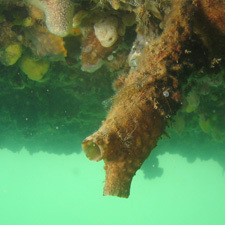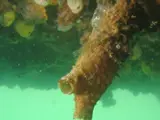 Clubbed tunicate
Clubbed tunicate
Common name: Clubbed tunicate
Botanical name: Styela clava
Management programme: Progressive Containment
Where is it originally from?
Tunicates are commonly known as sea squirts because, when removed from the water, they contract and squirt water that had been circulating around their body. The clubbed tunicate is native to the North West Pacific and is thought to have arrived in New Zealand as an unwanted hitchhiker on a vessel.
Why is it a pest?
- It forms dense colonies, competing for space and food with native species (e.g. mussels, oysters).
- It fouls marine farming lines, vessel hulls and other marine structures.
- They can grow rapidly, reaching densities of up to 500-1,500 individuals per square metre.
- It can withstand sub-zero temperatures and up to 23 degrees meaning it can invade a wide range of places.
- Highly effective filter feeder often preying on larvae of commercially important fisheries species.
Where is it found?
- The clubbed tunicate can be found up to 25m deep, attaching itself to rocky coastlines, reefs, boat hulls, wharves, pontoons, and aquaculture structures.
- The clubbed tunicate can be spread on vessels, whether as larvae held in ballast water or as hull fouling. Or it can be dispersed through larvae being moved by water currents.
- It has become widespread throughout Auckland’s Hauraki Gulf and has been found in the Coromandel Harbour, parts of Lyttelton Harbour, Nelson Harbour, and Northland.
- In the Bay of Plenty the clubbed tunicate has been found on vessel hulls and piles within the Tauranga Harbour but has not become established.
What does it look like?
- A sea squirt with a long, club shaped body up to 160mm long, on a tough stalk.
- Its surface is tough, leathery, rumpled, and knobbly.
- They can be brownish-white, yellowish-brown, or reddish-brown.
- Two closely spaced siphons at the top of the body usually surrounded by warty little bumps.
- Often appears fuzzy when viewed under water.
What are the rules?
Progressive Containment
Progressive Containment species are pests which the Council aims to prevent from spreading, reduce the distribution, or eradicate within parts of the region over time. Landowners or occupiers are responsible for the control of Progressive Containment species on their property. Council may enforce the control of these pest species.
What are the rules around keeping boat hulls clean and transporting Marine pests?
- Keep your boat bottom and any niche areas clean (no more than light slime, all the time).
- Keep your anti-fouling paint fresh - manufacturers usually recommend replacement every 1-2 years.
- Check your hull before you travel to a new area, every time.
- If your boat is heavily fouled, haul it out. Cleaning underwater will only spread any pests that may be hiding on there.
To prevent the spread of marine pests, Bay of Plenty marinas require visiting vessels to have been recently cleaned. That means:
- Antifouled in the last six months.
- Lifted and washed in the last month.
Check with the marina what proof is required. Some high-risk vessels may be subject to additional marina requirements.
Tauranga marinas have their own hull hygiene rules for visiting vessels. Plan ahead - contact Tauranga Bridge Marina on 07 575 8264 or Tauranga Marina on 07 578 8747 for details.
How do you get rid of it?
It is important to ensure vessels are clean from invasive pests before entering the Bay of Plenty. If pests are found on your boat you may be asked to haul it out for cleaning.
If you spot clubbed tunicate in the Bay of Plenty, please kill it, keep the sample and contact the Bay of Plenty Regional Council on 0800 STOP PESTS (0800 786 773).
Images

